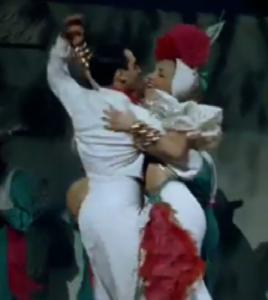- Historical Dance
- Jazz Age Social Dancing ("The Modern Dances")
- 0. The Essentials of Jazz Age Ballroom Dancing
- 1. Foxtrot Part 1: The Jazz Age Foxtrot
- 2. Youth Dancing in the Jazz Age
- 3. The Jazz Age Waltz
- 4. The Jazz Age Tango
- 5. 1930s Rumba
- 6. 1930s Samba
- 7. 1930s Conga
- 8. Bal Musette: Parisian Dance of the Jazz Age
- 9. Dancing in Weimar Berlin
- Dancing Made Easy - 1922
- Film Library - Jazz Age Dance
- Historical Dance Films posted to Pinterest
- Jazz Age Dance - Apologia
- Jazz Age Dance Image Collection
- Jazz Age Lead and Follow
- Places to Dance in Southern California in the Jazz Age
- Sampler of Jazz Age Dance Holds
- The Pathé Historical Dance Collection: 1920s-40s
- Ragtime Dance - the One Step
- Regency Dance
- Victorian Dance
- Jazz Age Social Dancing ("The Modern Dances")
6. 1930s Samba
The Samba has its roots in Brazil. Just as the Rumba started as an Afro-Cuban solo dance and was modified to turn it into a ballroom-suitable couple dance, the Afro-Brazilian solo Samba was modified and civilized for the social dancers of North American and Europe.
It does not seem to have been quite as popular as the Rumba, but was a standard feature of the Latin repertoire starting in the mid '30s.
The Samba is in a very lively 2/4 time. To do the basic step, step on every beat. The instructions below are for the basic time step and are for the man. The lady does the opposite. Take small steps. Step on the balls of your feet and keep your knees limber. Let your whole body move to the music.
Each number is a beat.
1. Man steps forward with his left foot.
2. Man steps forward with his right foot.
3. Man steps back with his left foot.
4. Man steps back with this right foot.
Unlike the Rumba, where the partners maintain an open frame, the clear majority of Samba dancers in the films of the time seem to be keeping the close hold of the Foxtrot - while a few take a more open frame, or separate for a few steps and then return to the close hold.
With ballroom Samba dancers, the hip swinging action is there but is a bit more subtle than with the Rumba. When you are in an ultra-close '30s dance hold, just a little hip action goes a long way.
The time step above is the default, when-you-aren't-doing-something-more-interesting step. As with all the other ballroom dances of the time, it's not important exactly what your feet are doing. They go where they have to go to get the job done. What ever you do is fine as long as it works and you stay on the beat. It is, essentially, a Latin One-Step, with all the flexibility that entails.
You have a lot of options for variations and the step lends itself to lots of rotation. The signature spin is a sort of cork-screw with the arms raised. You can see it in the picture on this page and all the clips in the attached videos, especially at the very end of the first one. Also, if you are feeling particularly white, you can Foxtrot to it, as Don Ameche does at the beginning of the clip in the first video.
As with the Rumba, the dancers have the option of separating to do solo bits. The final sequence of the first video shows a spectacular demonstration with Carmen Miranda and a capable partner. What they are doing is far more than you would be likely to see on any normal dance floor, but some of moves might be something you could adapt to your routine, if you like to put on a show when you dance.
The second video is a scene with Ricardo Mantalban, Rita Moreno and Lana Turner demonstrating a wonderful, smooth, Samba. It's from the 1953 film "Latin Lovers" - a bit outside our period, but I think it's still a serviceable guide to how to Samba like, well, a Latin lover.

